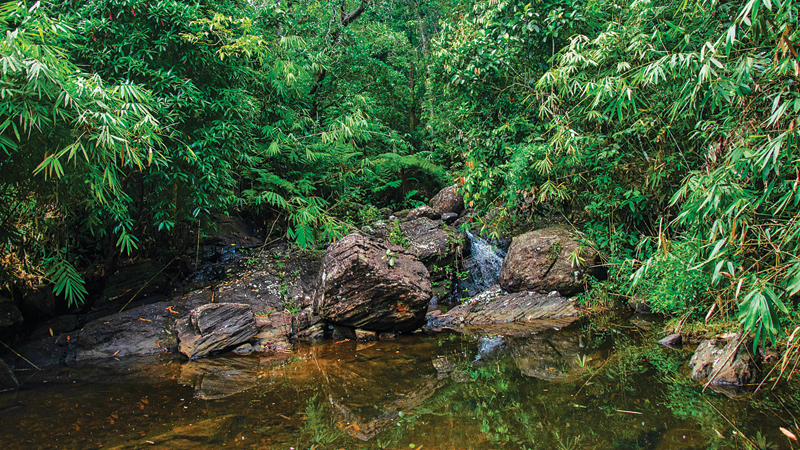Pinkish-purple and deep purple blotch: the lush mountain peak in Pimbura near Ayagama in the Ratnapura district has an exotic native wild orchid flower known as ‘Vesak Mal.’
 I love Vesak orchid flowers. Botalegama, a village in Bulathsinhala in the Eastern part of the Kalutara district where I was born, I have spotted this beautiful purple violet Vesak orchid flower which grows on top of the towering trees during the Vesak season. A few Vesak orchid plants had been planted by my parents on trees around my home garden. It was mesmerising to watch the blossoming of these purple flowers against greenery. Sometimes as boys we crept to the nearby forest to collect these orchid plants and plant them in our home garden.
I love Vesak orchid flowers. Botalegama, a village in Bulathsinhala in the Eastern part of the Kalutara district where I was born, I have spotted this beautiful purple violet Vesak orchid flower which grows on top of the towering trees during the Vesak season. A few Vesak orchid plants had been planted by my parents on trees around my home garden. It was mesmerising to watch the blossoming of these purple flowers against greenery. Sometimes as boys we crept to the nearby forest to collect these orchid plants and plant them in our home garden.
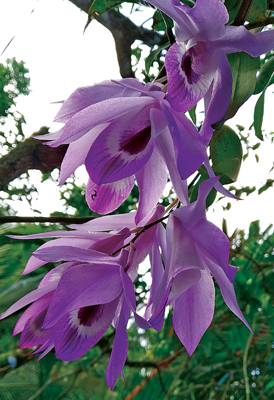
With the petals of its
pinkish-purple flowers spread out
“I want to capture the ‘Vesak Mal’ on my camera,” I told my younger son in the beginning of May. Between April and May, one can witness the pinkish-purple beautiful ‘Vesak Mal’ (botanical name Dendrobium mccarthiae) on tall trees which are rare and fast vanishing. The endemic native orchid flower, grows especially, in ecosystems of wet zone tropical rainforest patches in the outskirts of the Sinharaja forest in the Ratnapura district and also in the Eastern part of the Kalutara district.
“I have a friend, Asiri Sampath in Ayagama, who knows well about the Vesak Mal. I can contact him,” my son said eagerly. I was much interested because I had seen Vesak Mal in this village sometime back and thought it would be a rare opportunity for me to capture the stunning images of the exotic flower. It blooms in May, the month of Vesak, thus it is named Vesak Mal.
One morning we reached Asiri Sampath’s residence, driving along the highway on a steep meandering road, punctuated with hair-pin bends, connecting Ayagama and Pimbura on the Ratnapura-Panadura highway via Idangoda.
Kukulugala peak wilderness
Asiri joined us and our final destination was the Kukulugala peak wilderness (elevation 704m). It lies in the South of Ratnapura, on the Northern boundary of the Sinharaja forest near Pimbura. Its mean annual rainfall ranges between 1,500 -2,000mm.
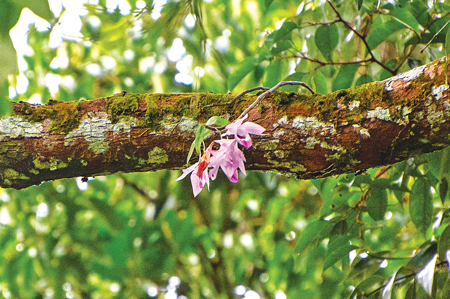
A Vesak orchid plant, endemic to Sri Lanka, grows on mossy tree
branches around 15 metres above the ground on a tree canopy
We headed towards the East of the village, with the imposing Kukulugala mountain range in the background. A smooth drive on the five-kilometre stretch took us to the village of Pumbura. The road was deserted and the environment silent, not being motorable further up. Asiri told us to park the car in the compound of a village house and we decided to trek the rest of the mountain.
Young nature lover, Asiri Sampath took us to the Kukulugala forest patches through tea plantations. To my surprise, I spotted a cluster of Vesak flowers in full bloom in the forest canopy near a stream. The late morning sun shone brightly and the heat slowed our pace. It took us around two hours to reach the summit of the Kukulugala forest patches.
Vesak flowers thrive in the humid climate in the low-country wet zone up to an elevation of about 2,000 feet and are frequently found in the South Western lowland forest patches in the Ratnapura district and the Eastern part of the Kalutara district.
The Vesak flower grows on the trunks of mature trees, with no connections to soil, nor does it get any nourishment from the host tree. The mass of roots to which the plant is attached gathers decaying plant matter creating moss from which it draws the nutrients. The flowers bloom on mature trees about eight metres above ground.
The Vesak flower is an epiphyte plant that grows on tall trees with heavy barks, getting moisture and nutrients from the air, rain and sometimes from debris accumulating around it. The species grows on the upper parts of tree trunks and on large branches of mature trees. The flowers which last more than two weeks gradually wither, making seeds from the stems of the dying flower for their offspring.
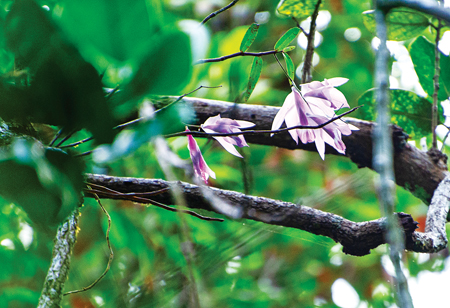
The Vesak orchid flowers on a branch of a tree more than 15 metres above the ground
Vesak flowers, large and faintly scented, are produced in pairs at the nodes of the leafless stem (pedudo bulb), each three inches in length and about the same in breadth. They are pinkish-purple with the labellum (lower petal) purple with a pinkish border, and a deep purple blotch at the throat, and have a drooping trait. The flowering season coincides with the monsoon.
Fast vanishing flower
On the foothill of the mountain, we met a villager, Dharmawardena, who had been obsessed with the Vesak flowers since his childhood in his village, Pimbura. He says the flower is fast vanishing and is rarely seen blooming in the Vesak season at present.
The Vesak orchid was featured in Sri Lankan postal stamps twice. The first stamp depicting a Vesak flower was a 15-cent stamp issued in 1950 and the second stamp was issued in 1994. These stamps showed the Vesak flower, as one of the most beautiful native orchids. It has also been the official flower of the Sabaragamuwa Province.
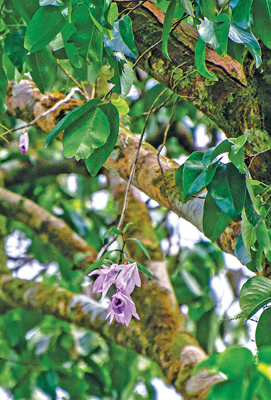
Vesak orchid flowers blossom with
its attractive colour pinkish-purple
This beautiful wild orchid was named in 1855 in honour of Lady McCarthy, wife of Sir Charles MaCarthy, then Governor of Ceylon. The flower has become a collectors’ item since colonial days because it was endemic to Sri Lanka and led to its decline in the 1900s. This led to its listing as a protected species in 1937 under the Fauna and Flora Ordinance.
According to observations, one of the causes for the depletion of the Vesak flower is the destruction of the wet zone rainforest reserves which are its natural habitat. “Visitors and even villagers uproot these plants from the forest and re-plant them in their homes. This leads to the decline of the flower from the forest patches,” Dharmawardena said. The Vesak flower is protected by law. However, the law alone will not be able to save the Vesak orchid, the biggest threat to its survival being the destruction of its natural habitat. At the same time, logging of mature trees and encroachment of humans into its ecosystem has vastly reduced their numbers.
Enthralled by viewing the Vesak flowers in the forest canopy, we started our descent after three hours in the company of the young nature lover, Asiri. Kukulugala, once rich with Vesak Orchid flowers, is a perfect place for nature lovers.






